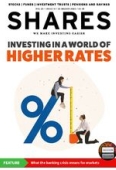Archived article
Please note that tax, investment, pension and ISA rules can change and the information and any views contained in this article may now be inaccurate.
What should your investment portfolio look like in your 70s?

This article follows on directly from last week’s look at investing in your 60s by moving forward a decade to identify the factors affecting investors in their 70s.
By this age most investors will be retired or are very close to giving up on full-time work. The article assumes an investor has entered drawdown rather than purchasing an annuity which converts a fixed lump sum into a monthly income for life. Although beyond the scope of the article it is important to consider the most tax efficient way to take retirement income including taking advantage of the 25% tax free lump withdrawal.
At 70 years of age, with good luck and judgement, and no income withdrawn, a typical share-only investment pot would have just about doubled from a decade earlier assuming long-term annual total equity returns of around 7% a year.
As discussed in the previous article the average life expectancy for women is 87 years while for men it is 84 years which means there is still plenty of investment runway ahead, assuming good health.
But while it made sense to keep a good proportion invested in stocks and shares at 60 years of age, beyond 70 it becomes more important to strike a conservative balance between safer fixed income investments, cash and shares.
The main reason is related to the uncertainty and volatility of stock markets which can move down unexpectedly and temporarily reduce the value of your pot at the most inconvenient times.
This puts a premium on constructing a portfolio which balances the need to generate income, offers an element of capital protection whilst also not ignoring the need for some capital appreciation.
MEDICAL COSTS CAN BE EXPENSIVE
Age-related illnesses become more likely with the passage of time and can strike unexpectedly. Keeping a progressively higher cash balance as you move through your 70s is a prudent step towards meeting increased medical expenses and dialling down your risk exposure.
It is worth pointing out that care home costs can be expensive depending on the facilities and location. From October 2023 the government will introduce a new £86,000 cap on the amount anyone in England will need to spend on personal care over a lifetime. The point at which people become eligible to receive support will increase from £23,250 to £100,000.
People with less than £100,000 of assets will never contribute more than 20% of these assets per year. People with assets below £20,000 will no longer contribute from assets but only what they can afford from income.
ARE BONDS RISKY?
Although targeted funds are popular in the US for providing age-based retirement plans they have a mixed reputation.
They aim to allocate a bigger proportion to bonds as investors age to reduce risk. The Vanguard product allocates 75% to bonds from the age of 70 as the chart demonstrates.
Fixed income investing requires specialist knowledge and given bonds will typically comprise the bulk of a portfolio from the age of 70, it makes sense for most investors to access these markets through active and passively managed funds.
This can be done via dedicated bond funds investing in different parts of the fixed income markets or selecting specialist managers which are discussed later.
It is worth highlighting that bond markets had a horrible time over the last year caused by aggressive interest rate increases from central banks. Bond prices move in the opposite direction to yields.
This means bonds did not provide their customary protection against falling stock markets in 2022 with global bonds losing 14% of their value.
However, with 10-year UK government bonds yielding 3.4% and investment grade corporate bonds over 5% the landscape has changed dramatically over the last 12 months.
Bonds provide a decent income for the first time in decades and with the interest rate hiking cycle now likely in its late stages bonds have a good chance of re-establishing their traditional protection in falling stock markets.
Despite inflation appearing stickier than economists originally thought there are signs it is falling steadily. The OBR (Office for Budget Responsibility) said in last week’s spring budget it expected inflation to fall to 2.9% by the end of the year and 0.1% by 2025. Falling inflation and interest rates should provide a positive tailwind for bonds.
BOND RISK LADDER
There is a risk spectrum to consider in bonds with government bonds being the least risky and high yield bonds the riskiest. Government bonds are also called gilts in the UK.
To compensate for higher risk, high yield bonds offer a spread over government bonds which is currently around 5%.
In the government bond markets longer dated issues are riskier than shorter dated ones. This means longer dated bond prices are more sensitive (both up and down) to a move in interest rates.
UK short dated two-year bonds yield 3.3% in line with 10-year bonds. Higher yields and income can be achieved by looking outside the UK to emerging markets, but they are riskier and exposed to currency effects which can wipe out the extra yield.
For investors looking to add bond exposure a good starting point is to consider the broad-based Lxyor FTSE Actuaries UK Gilts ETF (GILS) which invests across the entire UK Gilts market. It has an ongoing charge of 0.05% a year.
Alternatively, for access to the shorter end of the UK market consider the Lxyor FTSE Actuaries UK Gilts 0-5-year ETF (GIL5) which has the same ongoing charge.
MOVING UP THE RISK LADDER
The investment grade corporate bond market offers a return over and above government bonds of around 1.5%.
Investment grade refers to the highest quality part of the market and these companies have stronger balance sheets which should make them more resilient in an economic downturn.
The iShares GBP Corporate Bond ETF (SLXX) has a trailing yield of 2.74% and an ongoing charge of 0.2% a year.
An actively managed bond fund to consider which has the flexibility to invest across all types of bonds and is currently defensively positioned is the Allianz Strategic Bond Fund (BYT2QW8).
MULTI-ASSET AND LIFESTYLE FUNDS
If the prospect of deciding an appropriate asset allocation is too intimidating, there are readymade asset allocation options available via ‘one-stop-shop multi-asset funds and Lifestyle funds.
One Lifestyle fund to consider is the Vanguard LifeStrategy 20% Equity Fund (B462029) which invests 20% in shares and 80% in fixed income.
The £1.6 billion fund has a trailing yield of 1.5% and an ongoing charge of 0.22% a year. Just over a third of the fund is invested in UK and European assets, around a half in the US and the rest in Greater Asia.
For those looking for greater proportion in shares the 40-60 version (B41F6L43) could be considered.
In the multi-asset space, there are funds available which limit their equity exposure to a maximum of 20%.
One of the best performers in this category is the Fidelity Multi Asset Open Defensive Acc in GBP (BC7GXK5). The fund targets an annual total return after ongoing fees of 4% a year over a typical market cycle of five to seven years.
It has an ongoing charge of 1.01%, a trailing yield of 2.1% and has delivered a gain in net asset value of 10.87% over the last three years.
Currently the portfolio has a low 0.6% exposure to equities and its three largest positions make up close to half of the assets. The fund holds its bond exposure through two funds and some direct exposure to US treasuries.
The largest position (34%) is a holding in the Fidelity Global Aggregate Bond GBP Acc Fund (BC7GXK5). A further 11% of assets are in short term US treasury bonds and 10% of assets are invested in the Jupiter Strategic Bond Acc Fund (B4T6SD5).
While this article has focused on the fixed income component of a portfolio, remember the portion in stock and shares could also be tilted towards dividend-payers to complement income while providing some capital growth.
Important information:
These articles are provided by Shares magazine which is published by AJ Bell Media, a part of AJ Bell. Shares is not written by AJ Bell.
Shares is provided for your general information and use and is not a personal recommendation to invest. It is not intended to be relied upon by you in making or not making any investment decisions. The investments referred to in these articles will not be suitable for all investors. If in doubt please seek appropriate independent financial advice.
Investors acting on the information in these articles do so at their own risk and AJ Bell Media and its staff do not accept liability for losses suffered by investors as a result of their investment decisions.
Issue contents
Feature
- Why the Credit Suisse bailout has failed to calm investors’ nerves
- What an escalating AI-powered search war might mean for media stocks
- Investing in a world of higher rates
- What should your investment portfolio look like in your 70s?
- Discover the beneficiaries of China’s big reopening in 2023
- Why a company’s longevity is important to some of the best fund managers

 magazine
magazine








